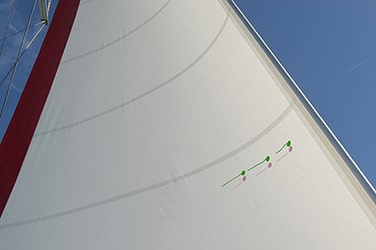Sail TellTales
Since we can’t see the wind flowing over the sail we use “telltales” attached to the sail in strategic positions to “tell” us what the wind is doing at that exact location. They are mounted on both sides of the sail to tell us what is happening to the airflow on either side.
If the telltales are flying smoothly backwards then they are telling us that the air at that point is flowing smoothly without turbulence and thus the sail is set at its best setting.
If the telltales are flying wildly it indicates that turbulent flow is happening due to less than optimal sail set and some trimming is needed.
Telltales are made of little strips of ribbon or string or threads of wool. Thus they are sometimes referred to as woolies.
On the port side of the sails, the telltales are red. On the starboard side of the sails, the telltales are green. Many times the telltales are mounted on a see-through mylar window. This way you can see both telltales at the same time.
Telltales are also placed vertically up the sail so that you can see if the sail is set properly at that height. In Module 3, you’ll learn how to trim a sail for efficiency at different vertical positions.
But right now we’re going to show you a representation of the wind as you trim the sail on a boat that is moving at 90 degrees to the wind.
Moving the slider bar represents pulling in on the jib sheet and you’ll see the sail begins to move towards the centerline. As this happens, you’ll observe the wind no longer able to turn the corner to stay attached to the sail shape. Turbulent flow is created and the lift force decreases dramatically. Also, notice that the pushing force turns more towards the beam of the boat and less facing forward. The result is that you’ll heel the boat over more and slow the boat down. The situation is called “over-trimmed”. As you ease the jib sheets out again you’ll see the flow begin to reattach and the forward-facing forces increase.






